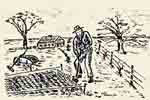

 |
 |
| Home | Index | Museums | Blog | Authors | Site Map | About |
|
The Passing of theStagecoach ErabyRichard PalmerLong before the Erie Canal was conceived, an elaborate network of interconnecting stagecoach routes criss-crossed New York State in all directions. Even the advent of the canal did not prove to be much competition because it was slow. It was the coming of the railroad that spelled the death knell of the stagecoach which for more than 40 years had reigned as the primary mode of public transportation. But by 1840, the stagecoach proprietors knew their days were numbered. Travel was now at the parting of the ways. Stagecoaching continued to exist but a few more years to link disconnected railroad lines and serve the "back country." The old familiar advertisements of the "Telegraph," "Pilot," and "Eagle" lines disappeared from the local newspapers. In their place appeared the railroad timetables offering travelers transportation far superior to the jouncing coach. Stagecoaches to some degree remained until the chain of railroads was finally completed across the state, later known as the New York Central. The stagecoach proprietors knew the end was in sight and prepared for it, gradually shifting their efforts to new enterprises. The stage barns now took a sympathetic lurch with the tottering business of the wayside taverns. The departed stagecoach left a somber mark on the "old road." The long row of stalls where the horses had rattled their halter chains were now slips where hens hatched their broods. The stable-yard became a cemetery of broken coach bodies and wagons with iron work rusting away. Here, too, were the discarded fanning mills used to separate oats from chaff, and cutting boxes with a single-knife set at guillotine slant, under which the heads of oat-sheaves had fallen into a basket, to be devoured by the stage horses. Under a pile of chaff might be found a badly-worn curry comb-on the walls, horse collars, halters and harnesses hang in cob-webbed disarray. The departed stagecoaches, in a sense, left a trail of decay and depression in their wake along the weed-grown turnpikes. The business of the wayside inn dwindled and the steel pen grew rusty in the tumbler of birdshot, next to the old and yellowed guest register. The landlord dozed in lonely wistfulness on the porch, the clatter of galloping horses and bleating stage-horn echoing in his mind. The tavern lights grew dim with the passage of time and the turnpike gate banged with the wind dispassionately against the abandoned toll-house. What was an everyday way of life was now but a memory.
How Travelers once got to Auburn by 'Stages'In December, 1837, the newly-completed Auburn & Syracuse Railroad, which passed through the towns of Geddes, Camillus and Elridge, contracted with Col. John M. Sherwood of Auburn to operate the line using his horses and altered stagecoaches until such time as the company could afford to purchase locomotives. At the time, strap iron was also unavailable, so locomotive operation would have been impractical on the plain wooden rails that had been laid. Sherwood was one of the major partners in a consortium loosely called the "Old Line Mail," which had controlled public land transportation between Albany and Buffalo and had the mail contracts since about 1800. According to Thomas Y. How, Jr., treasurer, as recorded in the company letter book, the directors had decided it was in their interest to contract with Sherwood and also secure his business rather than compete against him. This arrangement lasted for about 14 months until locomotives were purchased from Rogers Locomotive Works of Patterson, N.J. Following is an account of a ride in one of the horse car trains from James S. Buckingham's "Travels in the Eastern and Western States of America," published in London in `1842. The author and his party had traveled by canal packet to Utica, and then by stagecoach to Syracuse. He noted that the journey from Utica to Syracuse, a little more than 50 miles, took eight hours, from 8 a.m. to 4 p.m. or an average of 6¼ miles per hour. "On the following morning, Thursday, August 9th [1838], we left Syracuse in a coach that conveyed us to a rail-way, beginning at a distance of 3 or 4 miles from the town, to take us to Auburn; but great was our disappointment at finding, that instead of a locomotive engine, the cars were drawn by horses, of which there were only two to draw about 20 passengers, the horses being placed one before the other, as tandems are driven, and not abreast. "The rails, too, were of wood instead of iron, and the rate of travelling was estimated to be about six miles an hour. We had to wait half an hour before starting, and our progress was then so tedious that we all thought of getting out to walk the distance, as the most expeditious mode of the two. To add to our mortification, we met a train of cars drawn by a single horse coming right against us, and, the rails being single, and the places for turning off being wide apart, we had to shift our tandem pair from the front to the hind part of the train, and be drawn back about a mile and a half to get off the track, and let our advancing rival go past us. "After a very tedious ride of four hours in performing 22 miles, we reached Auburn, the entrance to which was by the great State Prison, and the other public buildings, which gave it a very striking appearance." The Story of the "Runners"In the salad days of public transportation, there was a class of people called runners who solicited travel on railroads, steamboats, stagecoaches and canal packets and also for hotel patronage . The following article, which appeared in the Syracuse Daily Star on Saturday, May 20, 1847, graphically describes this long-vanished vocation.Travellers by Rail Road and Packet boats, have abundant reason to remember Syracuse. Surely their greeting is always cordial, whatever else may be said of it. No sooner do the cars or boats fairly "bring up," than a dozen or twenty voices simultaneously break forth- "Syracuse House!" "Empire, select your baggage for the Empire, gentlemen." "Globe Hotel, new House just opened." "Exchange, walk right in." "National Temperance House." "Take the Omnibus, sir, plenty of time to get your meals," &c., &C. To the end of a long chapter. Many of the passengers take matters very quietly, as though they were accustomed to such sallies; but quite as many are fairly dumfounded at the outset. They are far more perplexed as to "where to go" than ever Mr. Webster was; and it is sometimes really amusing to see them halting between two opinions. A few evenings since on the arrival of the Eastern cars, a tall, sandy complexioned, muscular man, middle aged, but evidently little acquainted with the ways of the world, emerged from one of the cars with carpet bag in hand, and as he proceeded towards the front doors, was tapped on the shoulder very good-naturedly by one of the runners, and asked to patronize his house. The stranger proceeded to make inquiries, as to prices, &c. Observing this hesitation, another knight came up and commenced to urge the superiority of his house. Another and still another gathered about the perplexed Vermonter, and as he became anxious yet undecided the porters waxed loud and earnest. "Will you get with me, sir?" Finally asked the first assailant. "Wall, I believe I will," he replied gravely, but this was only a signal for a renewed attack by the others. Eloquence, in prose and poetry, argument and illustration, were rallied on all hands. "What the devil does this mean!" exclaimed the stranger suddenly aroused, "Where am I" -and he made a rush for the porter who had proceeded towards the door with his carpet bag. "Let me have that; I believe you're all a set of robbers!" "Why, where are you going?" Anxiously inquired the runner. "Going, Going? Why I shall go to the d---l if I don't look out!" No sooner had he regained possession of his property than the terrified man ensconced himself in the cars. He didn't stop in Syracuse that night, though he was doubtless brought up somewhere ere this. The "runners" are by no means so desperate a set of fellows as he supposed them. It is their calling to secure whatever of patronage they can for their respective establishments; and if they are sometimes boisterous and over zealous it is not a fault altogether peculiar to their trade. It can at least be said of them that they rarely part without good nature, however sharp the competition between them. What is more, they very seldom impugn each other's veracity. When one gets off a "whopper," which, of course is very rarely the case, his competitor instinctively "matches" or says nothing. It takes a "genius" to be a "runner" now-a-days. © 2003, Richard PalmerCLR Blog | Site Map | Contact CLR |